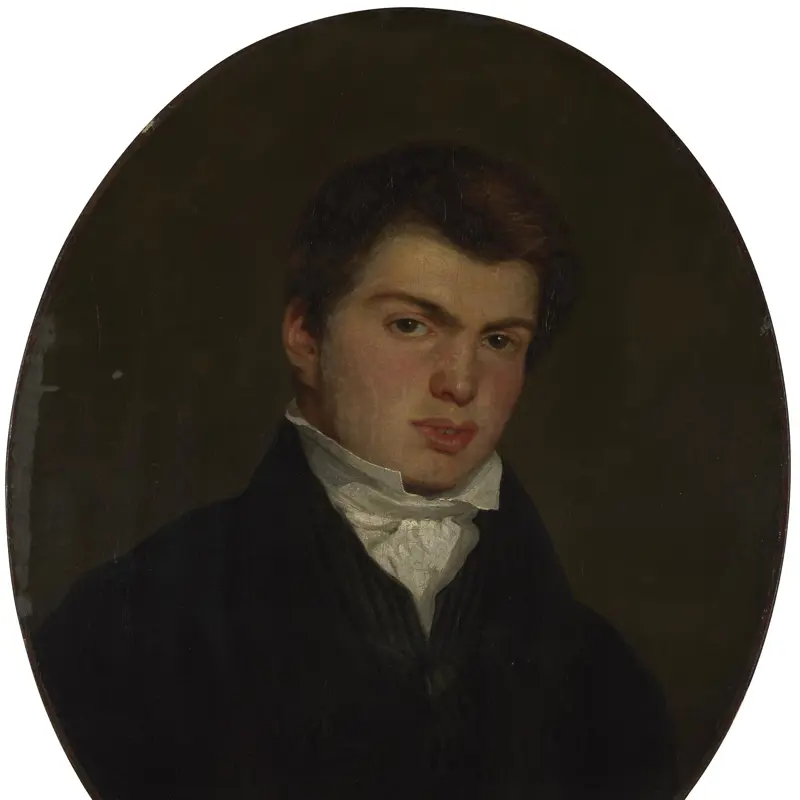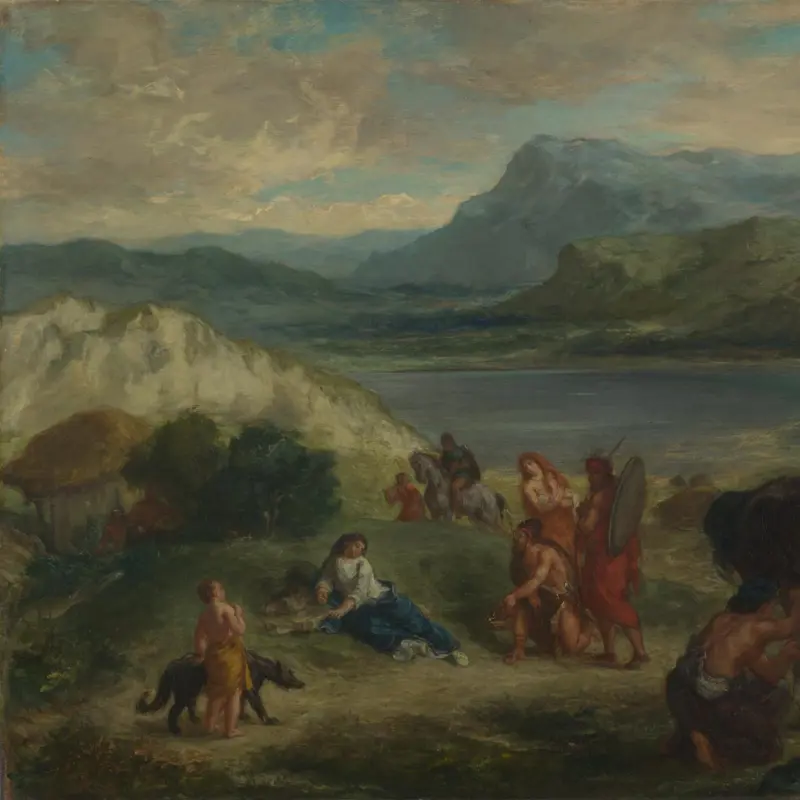Eugène Delacroix, 'Christ on the Cross', 1853
About the work
Overview
Delacroix depicts a moment from the Crucifixion, recounted in the Gospel of John (19: 25–30), when Christ speaks to his mother, the Virgin Mary, and one of his disciples, John, just before he dies. Christ’s mother, dressed in blue and yellow robes, collapses into the arms of Mary Cleophas and John. At the foot of the cross, Mary Magdalene prays as she looks up at Christ. Unusually, Delacroix also includes Judas Iscariot in the lower right corner.
Delacroix places us among the group at the foot of the Cross, as we too look up at Christ’s body. The use of colour is especially powerful as the greenish-grey pallor of Christ’s body is echoed by the greys and pinkish-browns of the stormy sky. The agitated brushwork combines expressive energy with the immediacy of a sketch.
Key facts
Details
- Full title
- Christ on the Cross
- Artist
- Eugène Delacroix
- Artist dates
- 1798 - 1863
- Date made
- 1853
- Medium and support
- Oil on canvas
- Dimensions
- 73.5 × 59.7 cm
- Inscription summary
- Signed; Dated
- Acquisition credit
- Bought, 1976
- Inventory number
- NG6433
- Location
- Room 38
- Collection
- Main Collection
- Frame
- 18th-century English Frame
Provenance
Additional information
This painting is included in a list of works with incomplete provenance from 1933–1945; for more information see Whereabouts of paintings 1933–1945.
Text extracted from the National Gallery’s Annual Report, ‘The National Gallery: July 1975 – December 1977’ and supplemented by Isobel Muir.
Exhibition history
-
2015Delacroix and the Rise of Modern ArtMinneapolis Institute of Art18 October 2015 - 10 January 2016The National Gallery (London)17 February 2016 - 22 May 2016
-
2018DelacroixMusée du Louvre26 March 2018 - 23 July 2018
Bibliography
-
1854F. Henriet, 'Le Musée des rues, I: Le Marchand de tableaux', L'Artiste, XIII, 1854, pp. 113-5
-
1855L. de Virmond, 'List of the Works of Delacroix', in T. Silvestre, Histoire des artistes vivants, français et étrangers, Paris 1855
-
1863'Chronique', L'Artiste, 1863
-
1885A. Robaut and E. Chesneau, L'oeuvre complet d'eugène Delacroix, Paris 1885
-
1911L. Roger-Milès, Vingt peintres du XIXe siècle. Chefs-d'oevre de l'école française (exh. cat. George Petit Gallery, 2 May - 31 May 1910), Paris 1911
-
1916E. Moreau-Nélaton, Delacroix, raconté par lui-même, Paris 1916
-
1922J. Meier-Graefe, Eugène Delacroix, Beiträge zu einer Analyse, Munich 1922
-
1926R. Escholier, Delacroix: Peintre, graveur, écrivain, 3 vols, Paris 1926
-
1930L. Hourticq, Delacroix, l'oeuvre du maître, Paris 1930
-
1931Galerie Paul Rosenberg, Exposition d'œuvres importantes de grands maitres du dix-neuvième siècle (exh. cat., Galerie Paul Rosenberg, 18 May 1931 - 27 June 1931), Paris 1931
-
1951V. Christoffel, Eugène Delacroix, Munich 1951
-
1971F. Trapp, The Attainment of Delacroix, Baltimore 1971
-
1975E. Hoffmann, 'Current and Forthcoming Exhibitions: Paris', The Burlington Magazine, 1975
-
1978The National Gallery, The National Gallery: July 1975 - December 1977, London 1978
-
1981L. Johnson, The Paintings of Eugène Delacroix: A Critical Catalogue, 6 vols, Oxford 1981
-
1982W.R. Johnston, The Nineteenth-Century Paintings in the Walters Art Gallery, Baltimore 1982
-
1993A. Daguerre de Hureaux, Delacroix, Paris 1993
-
2001
C. Baker and T. Henry, The National Gallery: Complete Illustrated Catalogue, London 2001
About this record
If you know more about this work or have spotted an error, please contact us. Please note that exhibition histories are listed from 2009 onwards. Bibliographies may not be complete; more comprehensive information is available in the National Gallery Library.



